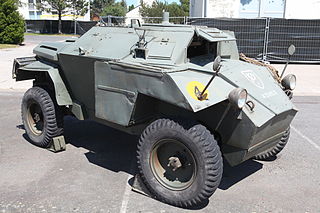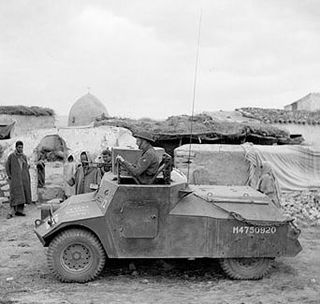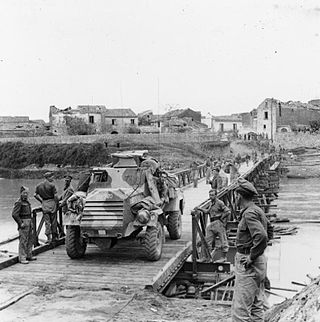
The AMX-13 is a French light tank produced from 1952 to 1987. It served with the French Army, as the Char 13t-75 Modèle 51, and was exported to more than 26 other nations. Named after its initial weight of 13 tonnes, and featuring a tough and reliable chassis, it was fitted with an oscillating turret built by GIAT Industries with revolver type magazines, which were also used on the Austrian SK-105 Kürassier. Including prototypes and export versions, over a hundred variants exist, including self-propelled guns, anti-aircraft systems, APCs, and ATGM versions.

The Cromwell tank, officially Tank, Cruiser, Mk VIII, Cromwell (A27M), was one of the series of cruiser tanks fielded by Britain in the Second World War. Named after the English Civil War-era military leader Oliver Cromwell, the Cromwell was the first tank put into service by the British to combine high speed from a powerful, reliable engine and reasonable armour. The intended dual-purpose high velocity gun could not be fitted in the turret, so a medium velocity dual purpose gun was fitted instead. Further development of the Cromwell combined with a high velocity gun led to the Comet tank.

The Universal Carrier, also known as the Bren Gun Carrier and sometimes simply the Bren Carrier from the light machine gun armament, is a common name describing a family of light armoured tracked vehicles built by Vickers-Armstrongs and other companies.

The Rolls-Royce Armoured Car is a British armoured car developed in 1914 and used during the First World War, Irish Civil War, the inter-war period in Imperial Air Control in Transjordan, Palestine and Mesopotamia, and in the early stages of the Second World War in the Middle East and North Africa.

The Daimler Armoured Car was a successful British armoured car design of the Second World War that continued in service into the 1950s. It was designed for armed reconnaissance and liaison purposes. During the postwar era, it doubled as an internal security vehicle in a number of countries.

The Humber Armoured Car was one of the most widely produced British armoured cars of the Second World War. It supplemented the Humber Light Reconnaissance Car and remained in service until the end of the war.

The Ferret armoured car, also commonly called the Ferret scout car, is a British armoured fighting vehicle designed and built for reconnaissance purposes. The Ferret was produced between 1952 and 1971 by the UK company Daimler. It was widely used by regiments in the British Army, as well as the RAF Regiment and Commonwealth countries throughout the period.

The Tank, Cruiser, Ram was a cruiser tank designed and built by Canada in the Second World War, based on the U.S. M3 Medium tank chassis. Due to standardization on the American Sherman tank for frontline units, it was used exclusively for training purposes and was never used in combat as a gun tank. The chassis was used for several other combat roles however, such as a flamethrower tank, observation post, and armoured personnel carrier.

The T17E1 Armoured Car was an American armored car design produced during the Second World War. It saw service with British and other Commonwealth forces during the war under the name Staghound, but was never used on the front line by US forces. A number of other countries used the Staghound after the war; some vehicles continued to serve until the 1980s.

The Marmon-Herrington Armoured Car was a series of armoured vehicles that were produced in South Africa and adopted by the British Army during the Second World War. RAF Armoured Car companies possessed them, but seem never to have used them in action, making greater use of Rolls-Royce Armoured Cars and other types.

Armoured Carrier, Wheeled, Indian Pattern (ACV-IP), known also as Indian Pattern Carrier or other similar names, was an armoured car produced in India during the Second World War. It was typically armed with a Bren light machine gun. Those produced by Tata Locomotives were called "Tatanagars" after the location of the works. 4,655 were produced, used by Indian units in the Far East and Mediterranean and Middle East Theatre, typically in divisional reconnaissance regiments.

The Humber Scout Car was a British light scout car used in the Second World War. It entered service in 1942 and continued in production until 1945. Designed for reconnaissance, and liaison between armoured units, it provided protection only against light arms fire, so was not a front line vehicle. More importantly it was small and fast and could quickly evade trouble. It became the shape format for the post war Ferret armoured car which began production in 1952.

The Humber Light Reconnaissance Car, also known as Humberette or Ironside, was a British armoured car produced during the Second World War.

Morris Light Reconnaissance Car (LRC) was a British light armoured car for reconnaissance use produced by Morris Motors Limited and used by the British during the Second World War.

Standard Car 4x2, or Car Armoured Light Standard, better known as the Beaverette, was a British improvised armoured car produced during the Second World War.

The Otter Light Reconnaissance Car (known officially by the British as Car, Light Reconnaissance, Canadian GM was a light armoured car produced in Canada during the Second World War for British and Commonwealth forces.

Car, Armoured, Heavy (Aust), also known as Rhino, was an armoured car designed in Australia during the Second World War. Due to enemy action and design problems the project never got beyond a prototype stage.

The Panhard EBR is an armoured car designed by Panhard for the French Army and later used across the globe, notably by the French Army during the Algerian War and by the Portuguese Army during the Overseas War.
The British Army made extensive use of a variety of combat vehicles during the Second World War. This article is a summary of those vehicles.

The Australian Armour and Artillery Museum is a privately-owned museum dedicated to tanks, armoured vehicles and artillery from the Second World War and post war periods. It was officially opened in 2014, in Cairns, Queensland, Australia.



















